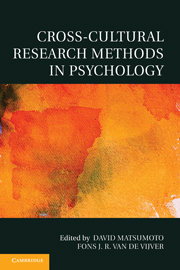Book contents
- Frontmatter
- Contents
- Contributors
- Cross-Cultural Research Methods in Psychology
- 1 Introduction to the Methodological Issues Associated With Cross-Cultural Research
- PART I Conceptual Issues and Design
- 2 Equivalence and Bias: A Review of Concepts, Models, and Data Analytic Procedures
- 3 Translating and Adapting Tests for Cross-Cultural Assessments
- Appendix Item Translation and Adaptation Review Form
- 4 Making Scientific Sense of Cultural Differences in Psychological Outcomes: Unpackaging the Magnum Mysterium
- 5 Sampling: The Selection of Cases for Culturally Comparative Psychological Research
- 6 Survey Response Styles Across Cultures
- Part II Data Analysis and Interpretation
- Name index
- Subject index
- References
3 - Translating and Adapting Tests for Cross-Cultural Assessments
Published online by Cambridge University Press: 05 June 2012
- Frontmatter
- Contents
- Contributors
- Cross-Cultural Research Methods in Psychology
- 1 Introduction to the Methodological Issues Associated With Cross-Cultural Research
- PART I Conceptual Issues and Design
- 2 Equivalence and Bias: A Review of Concepts, Models, and Data Analytic Procedures
- 3 Translating and Adapting Tests for Cross-Cultural Assessments
- Appendix Item Translation and Adaptation Review Form
- 4 Making Scientific Sense of Cultural Differences in Psychological Outcomes: Unpackaging the Magnum Mysterium
- 5 Sampling: The Selection of Cases for Culturally Comparative Psychological Research
- 6 Survey Response Styles Across Cultures
- Part II Data Analysis and Interpretation
- Name index
- Subject index
- References
Summary
Introduction
The number of educational and psychological measures being translated and adapted into multiple languages and cultures is very much on the increase. Cross-cultural research has become important in the fields of education and psychology, and articles addressing translation and adaptation over the past 30 years have increased by 350% (van de Vijver, 2009). Journals such as the European Journal of Psychological Assessment and the International Journal of Testing (see, e.g., the recent special issue on the topic of advances in test adaptation research, Gregoire & Hambleton, 2009) are full of articles either advancing the methodology for test translation and adaptation or describing initiatives to translate and adapt particular tests, especially popular intelligence, achievement, and personality tests. Interest among policy makers, educators, and the public in international comparative studies such as those sponsored by the Organization for Economic Cooperation and Development (OECD) (see the Programme for International Student Achievement and better known as PISA), and the International Association for the Evaluation of Educational Achievement (IEA) (see Trends in International Mathematics and Science Studies and better known as TIMSS), is also considerable. Because of the policy implications of these large-scale international assessments, governments are willing to spend large sums of money to see that these studies are carried out correctly. This means that state-of-the-art methodology for test translation and adaption is expected to be used. The use of the International Test Commission (ITC) Guidelines for Test Adaptation (see, e.g., Hambleton, 2005; van de Vijver & Hambleton, 1996) has become important to guide as well as to evaluate current initiatives to carry out test translation and adaptation studies.
The ITC Guidelines for Test Adaptation emphasize the importance of both judgmental reviews and the compilation of empirical evidence. For more on the types of empirical evidence, readers are referred to the edited book by Hambleton, Merenda, and Spielberger (2005), or they can read methodological articles such as the one prepared by van de Vijver and Tanzer (2004). Regarding judgmental reviews, what we have observed in practice is that those involved in the test translation and adaptation process are committed to conducting judgmental reviews, but a valid, empirically based judgmental review form to use is not often on hand to help guide this process. The ITC Guidelines highlight the importance of these judgmental reviews but provide only a few examples for how these judgmental reviews should be conducted across educational or psychological contexts. Sometimes review forms are developed in practice, though all too often they may be (a) incomplete (e.g., they may fail to address the issue of culture in producing a valid translation and adaptation of a test or fail to address many other important features), (b) unclear, or (c) inefficient because they include redundant questions or even irrelevant questions.
- Type
- Chapter
- Information
- Cross-Cultural Research Methods in Psychology , pp. 46 - 70Publisher: Cambridge University PressPrint publication year: 2010
References
- 40
- Cited by



